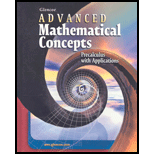FREE Answers for Advanced Mathematical Concepts: Precalculus with Applications, Student Edition
Q & A
Stuck on your homework?
Ask a question and get an expertly curated answer in as fast as 30 minutes.*
*Response times may vary by subject and question complexity. Median response time is 34 minutes for paid subscribers and may be longer for promotional offers and new subjects.
Browse All Chapters of This Textbook
Book Details
Advanced Mathematical Concepts, 2006 provides comprehensive coverage of all the topics covered in a full-year Pre-calculus course. Its unique unit organization readily allows for semester courses in Trigonometry, Discrete Mathematics, Analytic Geometry, and Algebra and Elementary Functions. Pacing and Chapter Charts for Semester Courses are conveniently located in the Teacher Wraparound Edition.
Advanced Mathematical Concepts lessons develop mathematics using numerous examples, real-world applications, and an engaging narrative. Graphs, diagrams, and illustrations are used throughout to help students visualize concepts. Directions clearly indicate which problems may require the use of a graphing calculator.
New Features:
" A full-color design, a wide range of exercise sets, relevant special features, and an emphasis on graphing and technology invite your students to experience the excitement of understanding and applying higher-level mathematics skills.
" Graphing calculator instructions is provided in the Graphing Calculator Appendix. Each Graphing Calculator Exploration provides a unique problem-solving situation.
" SAT/ACT Preparation is a feature of the chapter end matter. The Glencoe Web site offers additional practice: amc.glencoe.com
" Applications immediately engage your students; interest. Concepts are reinforced through a variety of examples and exercise sets that encourage students to write, read, practice, think logically, and review.
" Calculus concepts and skills are integrated throughout the course.
More Editions of This Book
Corresponding editions of this textbook are also available below:
